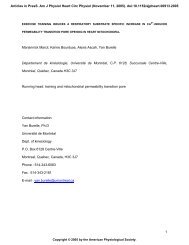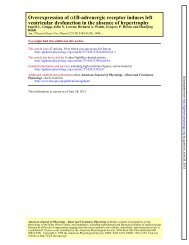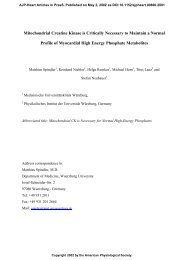The role of eNOS, iNOS and NFκB in upregulation and activation of ...
The role of eNOS, iNOS and NFκB in upregulation and activation of ...
The role of eNOS, iNOS and NFκB in upregulation and activation of ...
You also want an ePaper? Increase the reach of your titles
YUMPU automatically turns print PDFs into web optimized ePapers that Google loves.
Ye Y, et al. Mechanisms <strong>of</strong> COX2 <strong>upregulation</strong> by atorvastat<strong>in</strong> 18<br />
Previously we have shown that ATV upregulates COX2 expression <strong>and</strong> activity [2; 7;<br />
53]. Inhibit<strong>in</strong>g COX2, but not COX1 abrogated the IS-limit<strong>in</strong>g effect <strong>of</strong> ATV [2; 7].<br />
COX2 is essential for mediat<strong>in</strong>g the protective effect <strong>of</strong> delayed ischemic<br />
precondition<strong>in</strong>g, as COX2 <strong>in</strong>hibition abrogates IS limitation by precondition<strong>in</strong>g [10; 12;<br />
38; 39]. It is well established that NF B affects COX2 expression [10; 29; 40; 45].<br />
However, other pathways such as the JAK-STAT signal<strong>in</strong>g pathway [10; 45; 50; 51],<br />
PI3K through C/EBP or ERK via CREB can also upregulate COX2 expression<br />
<strong>in</strong>dependent <strong>of</strong> NF B [45]. Our data suggest that the <strong>upregulation</strong> <strong>of</strong> COX2 expression by<br />
oral ATV <strong>in</strong> the heart is <strong>in</strong>dependent <strong>of</strong> NF B, as COX2 expression was <strong>in</strong>creased by<br />
ATV <strong>in</strong> <strong>eNOS</strong> -/- mice, despite the fact that NF B was not activated. Moreover, <strong>in</strong> the<br />
<strong>iNOS</strong> -/- mice, COX2 expression was not <strong>in</strong>creased by ATV despite <strong>activation</strong> <strong>of</strong> NF B.<br />
Furthermore, SN50 did not block the ATV-<strong>in</strong>duction <strong>of</strong> COX2 expression, although it<br />
blocked <strong>iNOS</strong> <strong>in</strong>duction, support<strong>in</strong>g the fact that the <strong>in</strong>duction <strong>of</strong> <strong>iNOS</strong>, but not COX2 is<br />
NF B-dependent (Figure 6). In addition, AG490 also did not affect COX2 <strong>in</strong>duction by<br />
<strong>in</strong>traperitoneal ATV, suggest<strong>in</strong>g that COX2 <strong>in</strong>duction may be <strong>in</strong>dependent <strong>of</strong> JAK-STAT,<br />
<strong>in</strong> contrast to the f<strong>in</strong>d<strong>in</strong>gs <strong>in</strong> ischemic precondition<strong>in</strong>g [10]. Further studies are needed to<br />
clarify the <strong>role</strong> <strong>of</strong> JAK-STAT <strong>in</strong> mediat<strong>in</strong>g stat<strong>in</strong>-<strong>in</strong>duced myocardial protection.<br />
<strong>The</strong> dose <strong>of</strong> ATV used <strong>in</strong> the present study (10 mg/kg/d) may be considered high. Indeed,<br />
several <strong>in</strong>vestigators have shown reduction <strong>of</strong> IS with lower doses <strong>of</strong> stat<strong>in</strong>; however, <strong>in</strong><br />
all these studies stat<strong>in</strong>s were adm<strong>in</strong>istered <strong>in</strong>traperitoneally, subcutaneously or<br />
<strong>in</strong>travenously. In a dose rang<strong>in</strong>g study we have shown that 3-day oral pretreatment with<br />
ATV at 10 mg/kg/d <strong>and</strong> 75 mg/kg/d reduces IS <strong>in</strong> the rat [5], whereas at a dose <strong>of</strong> 1-2<br />
mg/kg/d oral ATV has no effect [5; 34]. Moreover, we have shown that <strong>in</strong> the rat, blood<br />
Copyright Information<br />
Page 18 <strong>of</strong> 35






